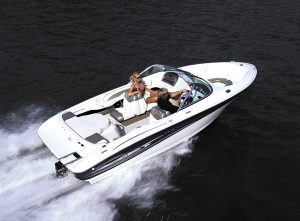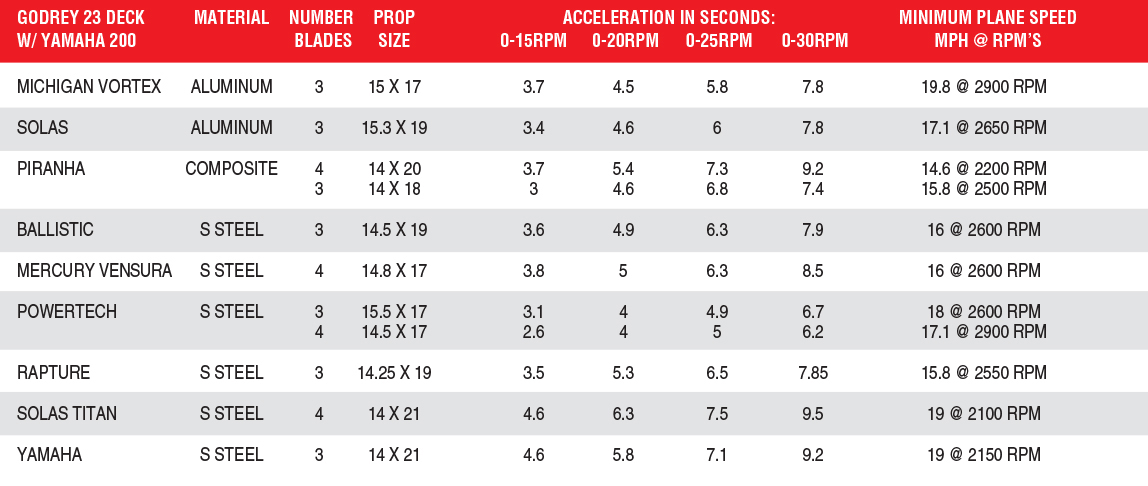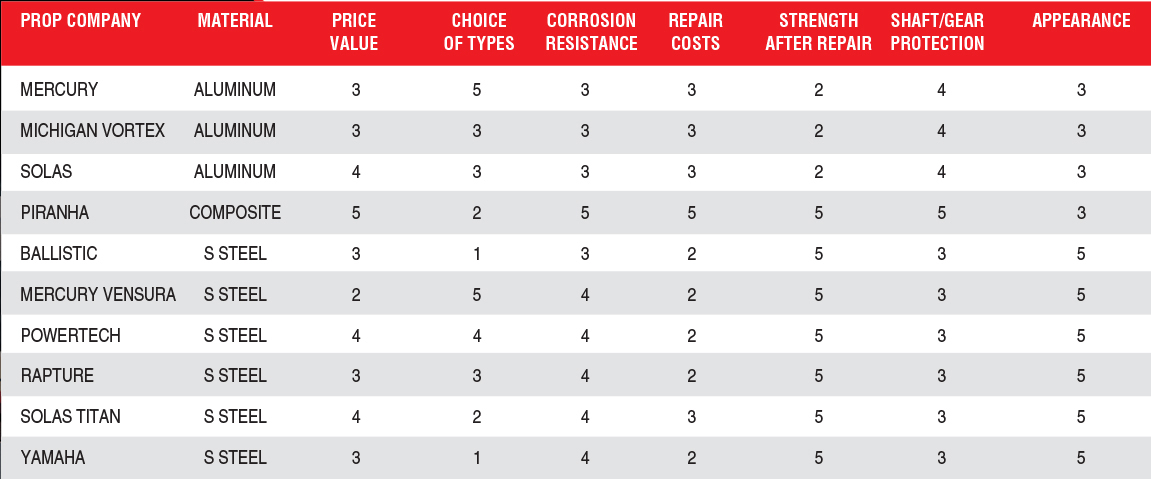In our last issue we reported on several underlying factors to help you choose the right propeller for your vessel and boating application. While the information was devised to please the most discriminationing boater, we decided to go beyond the call of duty and present a first-hand test on several of the latest props available, offering the top picks for you, your family and lifestyle.
By Bill Jennings


One of the first tasks for this extensive test was to establish a procedure that would record optimum performance details from a variety of different propeller sizes supplied by several major propeller sizes supplied by several major propeller manufacturers. Since we would have several props from each company, we restricted the test boats to two popular models, a 237 Sundeck Hurricane by Godfrey Marine powered by a 200 hp Yamaha outboard, and a Sea Ray 185 Sport boasting a 4.31 MerCruiser.
With the ground rules in place, dozens of propellers began arriving from manufacturers across North America, including Ballistic, Mercury, Michigan Wheel, Piranha, PowerTech, Solas and Yamaha. The testing tool place at the beautiful Sanibel Harbour Resort in Fort Myers, Florida, and our expert test team included two licensed captains, a radar operator, a computer operator, two/recorders and two prop changers.
Each prop was put through identical testing procedures. Acceleration was plotted on a graph, using a Stalker radar gun coupled to a tracking software program. The best of three runs were recorded. Speeds at increasing rpm levels (including WOT) were noted using both radar and GPS instruments. Cornering through pylon turns was also made with gradually increased entry speeds (until the speed was such that the propeller ventilated). Running on a long flat straight, engine trim was increased in 0.5-second increments to determine how much trim could be applied before the prop lost its grip on the water. In addition, a special features list was compiled to identify individual brand characteristics.
Using computers and handwritten data sheet, we meticulously recorded the various performance results over two full days. But this was just the beginning. Once the data was in chart form, it took several more days to properly analyze the individual results.
Many boaters believe manufacturers automatically supply a prop that is best matched to its boat. Unfortunately, this is not always the case. When we buy a car, the tires are matched up at the factory to suit the load requirements and roads used by all vehicles. Boat manufacturers, however, cannot predict where or how you plan to use your boat. Therefore, it is quite understandable that your prop may not be perfectly matched. Looking at the enclosed charts you will see some propellers of the same size delivered different results, while some propellers of different size delivered similar results. Therefore, the first lesson from our testing is that you need to try a variety of propellers to achieve your ultimate objective.


Repairing an aluminum prop or buying a used prop can be a bad investment since you have to heat aluminum to begin the repair process. However, heat changes its molecular structure and weakens it dramatically. If you simply smooth out nicks, or cut down a propeller, you’ll also change the shape (along with the resulting performance). Stainless props, on the other hand, can be effectively repaired and some composites props can even be returned to its original specs with a simple blade replacement.



Once you have decided on material and style, you now have to determine the size. If you need more traction for a heavy load or towing application, choose a larger diameter – like wider tires in a car. If your only concern is top speed, opt for a higher pitched prop, with a smaller diameter to allow the motor turn the required rpm. Always make handwritten notes to include the rpm, speed levels attained and the size of prop you are testing. When you test more than one prop, always choose a size that will closely match the manufacturer’s recommended maximum rpm level. Think of diameter and pitch as a balancing scale. If you are at the maximum rated rpm level, you can only go up in pitch if you go down in diameter or up in diameter if you go down in pitch. Talk it over with the service technicians at your local marina. Good propellers aren’t cheap, but the right one will make your boating far more enjoyable and deliver fuel savings that add up over the long haul.

MSQ4 four-bladed stainless prop.
All of the propellers we tested are from recognized and established manufacturers that produce a quality product. We found absolutely no duds or problematic props among the many tested. I was, however, able to draw three important recommendations.
Be Aware:
Understand there are many styles and sizes available for your boat and there is probably one out there that can deliver better performance with greater efficiency.
Experiment:
Once your research indicates what type of prop your boat most likely requires, your next step is to try as many different propellers as you can. Don’t be afraid to experiment. The time you spend trying different props will give a much better understanding of your boat and you will derive great satisfaction from determining the one that works best.

Don’t Compromise:
A prop is the wrong place to try and save money. Just look at the result differences between the props we tested. The extra dollars you may spend on the type and size is optimum for your particular application. It will deliver a tenfold return on your investment, both in fuel savings and satisfaction.
A propeller is a critical part of your boats drive train. Follow these suggestions and you will undoubtedly enjoy greater satisfaction from your boat.
Keyword : Ballistic, boating magazine, buying new outboards, engine review, marine power, Mercury, Mercury Marine, mercury racing, Mercury Verado, new motors, outboard reviews, outboards, Perfect Propeller, Piranha, PowerTech, Rapture, SOLAS, Solas Titan, upgrading boat engine, Vensura, Vortex, Yamaha Ballistic, boating magazine, buying new outboards, engine review, marine power, Mercury, Mercury Marine, mercury racing, Mercury Verado, new motors, outboard reviews, outboards, Perfect Propeller, Piranha, PowerTech, Rapture, SOLAS, Solas Titan, upgrading boat engine, Vensura, Vortex, Yamaha



